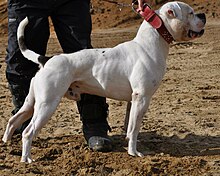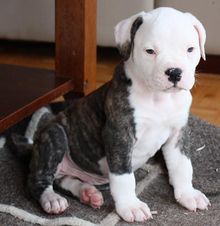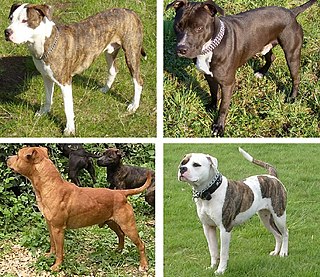
Pit bull is an umbrella term for several types of dog believed to have descended from bull and terriers. In the United states, the term is usually considered to include the American Pit Bull Terrier, American Staffordshire Terrier, American Bully, Staffordshire Bull Terrier, and sometimes the American Bulldog, along with any crossbred dog that shares certain physical characteristics with these breeds. In other countries, including the United Kingdom, the term is used as an abbreviation of the American Pit Bull Terrier breed specifically, while the Staffordshire Bull Terrier is not considered a pit bull. Most pit bull-type dogs descend from the British bull and terrier, a 19th-century dog-fighting type developed from crosses between the Old English Bulldog and the Old English Terrier.

The Boerboel is a South African breed of large dog of mastiff type, used as a family guard dog. It is large, with a short coat, strong bone structure and well-developed muscles.

The Bullmastiff is an English breed of dog of mastiff type and large size, with a solid build and a short muzzle. It was developed as a guard dog in the nineteenth century by cross-breeding the English Mastiff with the now-extinct Old English Bulldog. It was recognised as a breed by The Kennel Club in 1924.

The Bulldog is a British breed of dog of mastiff type. It may also be known as the English Bulldog or British Bulldog. It is a medium-sized, muscular dog of around 40–55 lb (18–25 kg). They have large heads with thick folds of skin around the face and shoulders and a relatively flat face with a protruding lower jaw. The breed has significant health issues as a consequence of breeding for its distinctive appearance, including brachycephaly, hip dysplasia, heat sensitivity, and skin infections. Due to concerns about their quality of life, breeding Bulldogs is illegal in Norway and the Netherlands.

The Staffordshire Bull Terrier, also called the Staffy or Stafford, is a purebred dog of small to medium size in the terrier group that originated in the northern parts of Birmingham and in the Black Country of Staffordshire, for which it is named. They descended from 19th-century bull terriers that were developed by crossing bulldogs with various terriers to create a generic type of dog generally known as bull and terriers. Staffords share the same ancestry with the modern Bull Terrier, although the two breeds developed along independent lines, and do not resemble each other. Modern Staffords more closely resemble the old type of bull terrier, and were first recognised as a purebred dog breed by The Kennel Club of Great Britain in 1935.
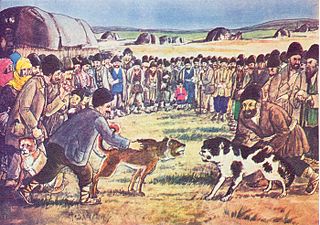
Dog fighting is a type of blood sport that turns game and fighting dogs against each other in a physical fight, often to the death, for the purposes of gambling or entertainment to the spectators. In rural areas, fights are often staged in barns or outdoor pits; in urban areas, fights are often staged in garages, basements, warehouses, alleyways, abandoned buildings, neighborhood playgrounds, or in the streets. Dog fights usually last until one dog is declared a winner, which occurs when one dog fails to scratch, dies, or jumps out of the pit. Sometimes dog fights end without declaring a winner; for instance, the dog's owner may call the fight.

The Boston Terrier is a breed of dog originating in the United States of America. This "American Gentleman" was accepted in 1893 by the American Kennel Club as a non-sporting breed. Boston Terriers are small and compact with a short tail and erect ears.

The French Bulldog, French: Bouledogue Français, is a French breed of companion dog or toy dog. It appeared in Paris in the mid-nineteenth century, apparently the result of cross-breeding of Toy Bulldogs imported from England and local Parisian ratters. It is commonly kept as a pet, and is among the most frequently registered dogs in a number of countries including Australia, the United Kingdom, and the United States. The breed is susceptible to various health issues as a consequence of breeding for their distinctive appearance, especially the brachycephalic face and skin wrinkles.

A mastiff is a large and powerful type of dog. Mastiffs are among the largest dogs, and typically have a short coat, a long low-set tail and large feet; the skull is large and bulky, the muzzle broad and short (brachycephalic) and the ears drooping and pendant-shaped. European and Asian records dating back 3,000 years show dogs of the mastiff type. Mastiffs have historically been guard dogs, protecting homes and property, although throughout history they have been used as hunting dogs, war dogs and for blood sports, such as fighting each other and other animals, including bulls, bears and even lions.
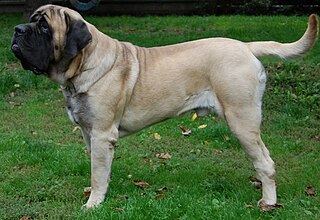
The English Mastiff, or simply the Mastiff, is a British dog breed of very large size. It is likely descended from the ancient Alaunt and Pugnaces Britanniae, with a significant input from the Alpine Mastiff in the 19th century. Distinguished by its enormous size, massive head, short coat in a limited range of colours, and always displaying a black mask, the Mastiff is noted for its gentle and loving nature. The lineage of modern dogs can be traced back to the early 19th century, but the modern type was stabilised in the 1880s and refined since. Following a period of sharp decline, the Mastiff has increased its worldwide popularity. Throughout its history the Mastiff has contributed to the development of a number of dog breeds, some generally known as mastiff-type dogs or, confusingly, just as "mastiffs". It is the largest living canine, outweighing the wolf by up to 50 kg (110 lbs) on average.

The American Staffordshire Terrier, also known as the AmStaff, is a medium-sized, short-coated American dog breed recognized by the American Kennel Club, but not the United Kennel Club, which instead allows American Staffordshire Terriers to be registered under the American Pit Bull Terrier breed.

The Olde English Bulldogge is an American dog breed, recognized by the United Kennel Club (UKC) in January 2014. The breed is listed in the UKC Guardian Dog Group. Five years prior to UKC recognition, the breed was registered by the former Canine Developmental, Health and Performance Registry (CDHPR), a privately held business located in Kalamazoo, Michigan. In the early 2000s, CDHPR had been working with the UKC under a unique agreement to develop breeding plans and strategies in an effort to produce improved breeds of dogs that would be accepted as purebred and, therefore, eligible for UKC registration.

The Alaunt is an extinct type of dog which came in different forms, with the original possibly having existed in North Caucasus, Central Asia and Europe from ancient times.

The Manchester Terrier is a breed of dog of the smooth-haired terrier type. It was first bred in the 19th century to control vermin, notably rats, at which it excelled. So efficient at the task was it that it often appeared in rat-baiting pits until that sport, which had effectively been illegal in the UK since 1835, finally died out at the beginning of the 20th century.

The Dogue de Bordeaux, Bordeaux Mastiff, French Mastiff or Bordeauxdog is a large French mastiff breed. A typical brachycephalic mastiff breed, the Bordeaux is a very powerful dog, with a very muscular body.

The Old English Bulldog is an extinct breed of dog.

The Córdoba fighting dog, was a type of dog, indigenous to Córdoba, Argentina, that resulted from crossbreeding old mastiff types of unknown pedigree. They were purposely bred for the sport of dog fighting until the early 20th century. They became extinct after dog fighting became illegal in Argentina in 1954.

The Bully Kutta is a type of large dog that originated in the Indian subcontinent, dating back to the 16th century. The Bully Kutta is a working dog used for hunting and guarding. The type is popular in the Punjab region of India and Pakistan, including Haryana and Delhi, as well as in Maharashtra and Tamil Nadu.

Bull and terrier was a common name for crossbreeds between bulldogs and terriers in the early 1800s. Other names included half-and-halfs and half-breds. It was a time in history when, for thousands of years, dogs were classified by use or function, unlike the modern pets of today that were bred to be conformation show dogs and family pets. Bull and terrier crosses were originally bred to function as fighting dogs for bull- and bear-baiting, and other popular blood sports during the Victorian era. The sport of bull baiting required a dog with attributes such as tenacity and courage, a wide frame with heavy bone, and a muscular, protruding jaw. By crossing bulldogs with various terriers from Ireland and Great Britain, breeders introduced "gameness and agility" into the hybrid mix.

The American Bully is a modern breed of dog that was developed as a companion dog, and originally standardized and recognized as a breed in 2004 by the American Bully Kennel Club (ABKC). Their published breed standard describes the dog as giving the "impression of great strength for its size". In 2008, the American Bully was recognized by the European Bully Kennel Club (EBKC), and on July 15, 2013, by the United Kennel Club (UKC). The UK Kennel Club, American Kennel Club, and International Canine Federation do not recognize the American Bully as a separate breed.
